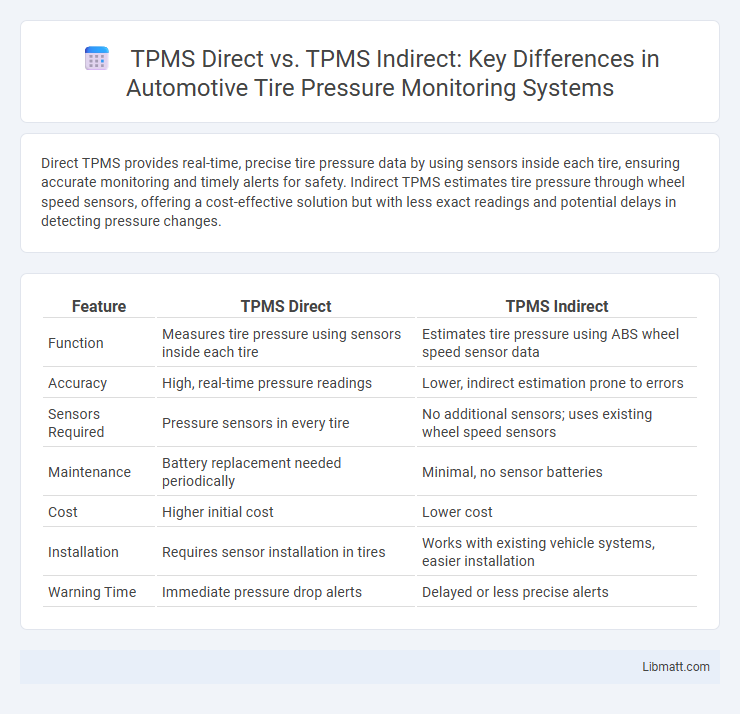Direct TPMS provides real-time, precise tire pressure data by using sensors inside each tire, ensuring accurate monitoring and timely alerts for safety. Indirect TPMS estimates tire pressure through wheel speed sensors, offering a cost-effective solution but with less exact readings and potential delays in detecting pressure changes.
Table of Comparison
| Feature | TPMS Direct | TPMS Indirect |
|---|---|---|
| Function | Measures tire pressure using sensors inside each tire | Estimates tire pressure using ABS wheel speed sensor data |
| Accuracy | High, real-time pressure readings | Lower, indirect estimation prone to errors |
| Sensors Required | Pressure sensors in every tire | No additional sensors; uses existing wheel speed sensors |
| Maintenance | Battery replacement needed periodically | Minimal, no sensor batteries |
| Cost | Higher initial cost | Lower cost |
| Installation | Requires sensor installation in tires | Works with existing vehicle systems, easier installation |
| Warning Time | Immediate pressure drop alerts | Delayed or less precise alerts |
Introduction to TPMS: Direct vs. Indirect
TPMS (Tire Pressure Monitoring Systems) come in two main types: direct and indirect. Direct TPMS uses pressure sensors mounted inside each tire to provide real-time, accurate tire pressure readings, enhancing safety and fuel efficiency. Indirect TPMS estimates tire pressure by monitoring wheel speed and rotational data via the ABS sensors, offering a cost-effective but less precise alternative.
How Direct TPMS Works
Direct TPMS uses sensors mounted on each tire to measure air pressure in real time and transmit data wirelessly to the vehicle's onboard computer. These sensors provide precise pressure readings, enabling immediate alerts when tire pressure falls below recommended levels, improving safety and fuel efficiency. Your vehicle's system displays exact tire pressure, helping you maintain optimal tire health and performance.
How Indirect TPMS Functions
Indirect TPMS utilizes wheel speed sensors from the ABS system to monitor tire rotation rates, detecting pressure loss by identifying variations in wheel speed. It does not measure tire pressure directly but infers under-inflation through differences in wheel circumference caused by lower pressure. You benefit from a cost-effective system that requires no additional sensors, though it may be less precise than direct TPMS.
Key Differences Between Direct and Indirect TPMS
Direct TPMS uses pressure sensors mounted inside each tire to provide real-time, accurate tire pressure readings, while indirect TPMS relies on monitoring wheel speed sensors from the ABS system to detect pressure changes indirectly. Direct systems offer precise individual tire pressure data and alerts, whereas indirect systems detect pressure loss by comparing rotational speeds, making them less accurate but more cost-effective. Your choice between direct and indirect TPMS can impact maintenance accuracy, sensor replacement costs, and overall vehicle safety.
Accuracy Comparison: Direct vs. Indirect TPMS
Direct TPMS provides precise tire pressure data by using sensors mounted inside each tire, offering real-time and highly accurate measurements. Indirect TPMS estimates tire pressure based on wheel speed data from the ABS system, which can be less accurate due to factors like tire wear or temperature changes. For your vehicle, choosing direct TPMS ensures reliable monitoring essential for safety and fuel efficiency.
Installation and Maintenance Requirements
TPMS direct systems require individual sensors mounted on each wheel to monitor tire pressure, necessitating periodic sensor battery replacement and recalibration during tire changes. TPMS indirect systems use existing wheel speed sensors within the ABS to estimate tire pressure, resulting in simpler installation and minimal maintenance since no additional hardware is needed. Direct TPMS offers precise pressure readings but involves higher maintenance costs, whereas indirect TPMS provides a cost-effective, low-maintenance alternative with less accuracy.
Cost Analysis: Direct and Indirect TPMS
Direct TPMS sensors typically incur higher upfront costs due to the need for individual pressure sensors on each tire, but offer precise real-time tire pressure data and ease of calibration. Indirect TPMS, integrated with the vehicle's ABS system, costs less initially as it uses existing wheel speed sensors without additional hardware, though it provides less accuracy and may require frequent recalibration. Evaluating your vehicle usage, maintenance budget, and accuracy needs can help determine the cost-effectiveness between direct and indirect TPMS solutions.
Pros and Cons of Direct TPMS
Direct TPMS provides real-time, accurate tire pressure readings by using sensors mounted inside each tire, enhancing safety and preventing premature tire wear. It requires sensor maintenance and battery replacement, which can increase costs and complexity compared to indirect TPMS. Your vehicle benefits from immediate alerts for pressure changes, but direct TPMS may have higher initial installation expenses.
Pros and Cons of Indirect TPMS
Indirect TPMS utilizes wheel speed sensors from the ABS system to estimate tire pressure, offering a cost-effective solution with easier installation and no need for additional hardware. However, its accuracy is limited since it cannot measure actual pressure, often leading to false alerts during temperature changes or tire rotations. Maintenance requires frequent recalibration, and it may fail to detect slow leaks promptly compared to direct TPMS systems.
Which TPMS Is Right for Your Vehicle?
Direct TPMS uses sensors installed inside each tire to monitor air pressure in real-time, providing precise and immediate data ideal for drivers who prioritize accuracy and safety. Indirect TPMS estimates tire pressure by analyzing wheel speed sensor data from your vehicle's ABS system, offering a cost-effective solution that requires no additional hardware but may be less accurate. Your choice depends on your vehicle compatibility, budget, and whether you prefer exact pressure readings or a more affordable, maintenance-free option.
TPMS direct vs TPMS indirect Infographic

 libmatt.com
libmatt.com